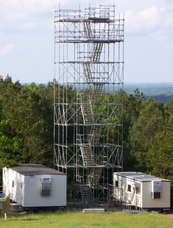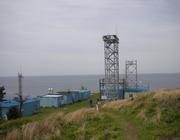
The Tropospheric Oxidation Capacity Research Group
Biosphere-Atmosphere-Human Interactions
3216 Croul Hall Irvine CA 92627 (email)

Contributions of primary and secondary biogenic VOC tototal OH reactivity during the CABINEX (Community Atmosphere-Biosphere INteractions Experiments)-09 field campaign
Journal:
Atmospheric Chemistry and PhysicsVolume Number:
11Issue Number:
16Pages:
8613-8623Abstract:
We present OH reactivity measurements using the comparative reactivity method with a branch enclosure technique for four different tree species (red oak, white pine, beech and red maple) in the UMBS PROPHET tower footprint during the Community Atmosphere Biosphere INteraction EXperiment (CABINEX) field campaign in July of 2009. Proton Transfer Reaction-Mass Spectrometry (PTR-MS) was sequentially used as a detector for OH reactivity and BVOC concentrations including isoprene and monoterpenes (MT) for enclosure air. Therefore, the measurement dataset contains both measured and calculated OH reactivity from well-known BVOC. The results indicate that isoprene and MT, and in one case a sesquiterpene, can account for the measured OH reactivity. Significant discrepancy between measured OH reactivity and calculated OH reactivity from isoprene and MT is found for the red maple enclosure dataset but it can be reconciled by adding reactivity from emission of a sesquiterpene, alpha-farnesene, detected by GC-MS. This leads us to conclude that no significant unknown BVOC emission contributed to ambient OH reactivity from these trees at least during the study period. However, this conclusion should be followed up by more comprehensive side-by-side inter-comparison between measured and calculated OH reactivity and laboratory experiments with controlled temperature and light environments to verify effects of those essential parameters towards unknown/unmeasured reactive BVOC emissions. This conclusion leads us to explore the contribution towards ambient OH reactivity (the dominant OH sink in this ecosystem) oxidation products such as hydroxyacetone, glyoxal, methylglyoxal and C4 and C5-hydroxycarbonyl using recently published isoprene oxidation mechanisms (Mainz Isoprene Mechanism II and Leuven Isoprene Mechanism). Evaluation of conventionally unmeasured first generation oxidation products of isoprene and their possible contribution to ambient missing OH reactivity indicates that the ratio of OH reactivity from unmeasured products over OH reactivity from MVK+MACR is strongly dependent on NO concentrations. The unmeasured oxidation products can contribute similar to 7.2% (8.8% from LIM and 5.6% by MIM 2 when NO = 100 pptv) of the isoprene contribution towards total ambient OH reactivity. This amount can explain similar to 8.0% (9.7% from LIM and 6.2% from MIM 2) of missing OH reactivity, reported by Di Carlo et al. (2004) at the same site. Further study on the contribution from further generation of unmeasured oxidation products is needed to constrain tropospheric photochemical reactivity of BVOC that have important implications for both photochemical ozone and secondary organic aerosol formation.
Notes:
Times Cited: 1
Related External URL:
<Go to ISI>://WOS:000294406300025- Citation:
- Kim, S, Guenther A, Karl T, Greenberg J. 2011. Contributions of primary and secondary biogenic VOC tototal OH reactivity during the CABINEX (Community Atmosphere-Biosphere INteractions Experiments)-09 field campaign. Atmospheric Chemistry and Physics. 11(16):8613-8623.

